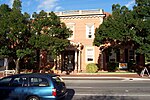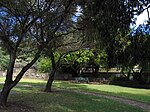City of Burnside

The City of Burnside is a local government area in the South Australian city of Adelaide stretching from the Adelaide Parklands into the Adelaide foothills with an area of 2,753 hectares (6,800 acres). It was founded in August 1856 as the District Council of Burnside, the name of a property of an early settler, and was classed as a city in 1943. The LGA is bounded by Adelaide, Adelaide Hills Council, Campbelltown, Mitcham, Norwood Payneham and St Peters and Unley. A primarily residential upper middle class area, Burnside has little to no industrial activity and a small commercial sector. Over 257 hectares (640 acres) of its area is dedicated to Parks and Reserves, the result being one of the greenest areas in Adelaide.It was one of the first areas outside of Adelaide to be settled, with the early villages of Magill, Burnside, Beaumont and Glen Osmond now inner suburbs. At the 2006 census, the city had a SEIFA score of 1108 (96th percentile), which was the highest figure for any local government area in South Australia – individual CCD scores ranged from 909 in eastern Glenside to 1194 in Stonyfell.
Excerpt from the Wikipedia article City of Burnside (License: CC BY-SA 3.0, Authors, Images).City of Burnside
Undelcarra Road, Adelaide Burnside
Geographical coordinates (GPS) Address Nearby Places Show on map
Geographical coordinates (GPS)
| Latitude | Longitude |
|---|---|
| N -34.933333333333 ° | E 138.66666666667 ° |
Address
Undelcarra Road 11
5066 Adelaide, Burnside
South Australia, Australia
Open on Google Maps




